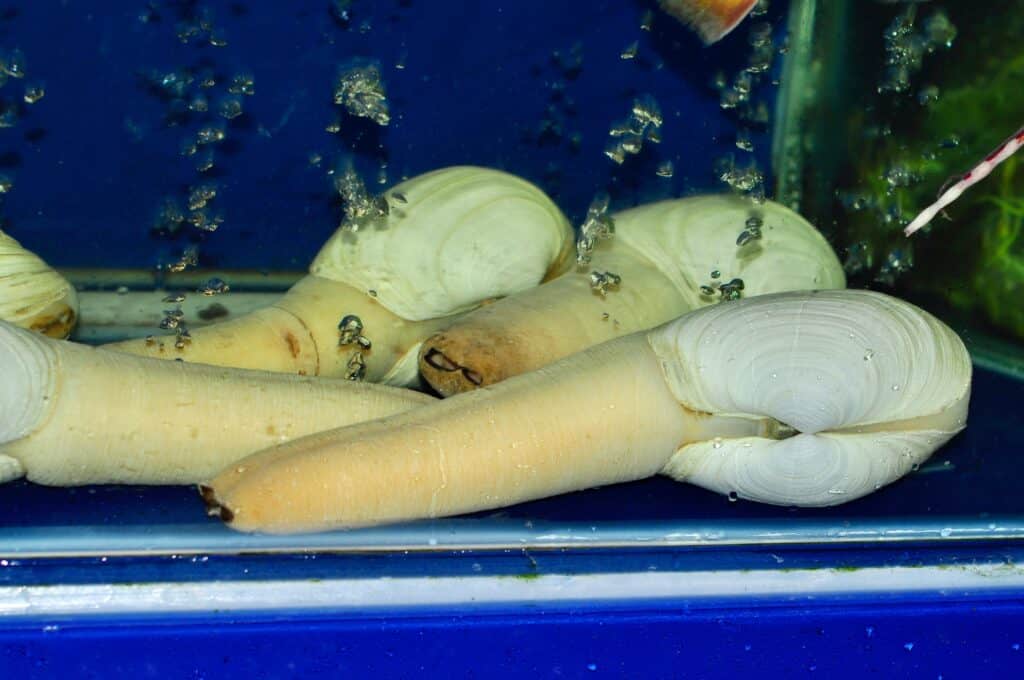Urechis unicinctus (Penis Fish)
Urechis unicinctus
Create "inns" for other sea creatures
Advertisement
Urechis unicinctus (Penis Fish) Scientific Classification
- Kingdom
- Animalia
- Phylum
- Annelida
- Class
- Polychaeta
- Order
- Echiuroidea
- Family
- Urechidae
- Genus
- Urechis
- Scientific Name
- Urechis unicinctus
Read our Complete Guide to Classification of Animals.
Urechis unicinctus (Penis Fish) Conservation Status
Urechis unicinctus (Penis Fish) Facts
- Prey
- Detritus, zooplankton, bacteria
- Main Prey
- Zooplankton
- Name Of Young
- Larva
- Group Behavior
- Solitary
- Fun Fact
- Create "inns" for other sea creatures
- Estimated Population Size
- Millions
- Biggest Threat
- Humans and predators
- Most Distinctive Feature
- Phallic shape
- Distinctive Feature
- Uses a mucous net to catch its prey
- Other Name(s)
- Garloid, innkeeper fish
- Habitat
- Sandy beaches and mud flats
- Predators
- Birds, sharks, rays, groupers
- Diet
- Omnivore
- Lifestyle
- Solitary
- Favorite Food
- Detritus
- Common Name
- Penis fish
- Special Features
- Creates a mucous net to catch food
- Number Of Species
- 1
- Location
- East Asia
View all of the Urechis unicinctus (Penis Fish) images!
Penis Fish Summary
Also known as the penis fish, Urechis unicinctus is a species of marine spoonworm found throughout East Asia. It feeds on microscopic organic material and creates burrows in sand and mud. Occasionally, large numbers may wash up and get stranded on beaches. They are a popular delicacy in Korea, China, and Japan.
5 Penis Fish Facts
- Small fish and crustaceans often live inside the U-shaped tunnels formed by this worm.
- Penis fish exude a mucous net that they use to capture plankton, bacteria, and detritus.
- Scientists have discovered U-shaped burrows resembling those made by the worm dating back nearly 300 million years ago.
- A penis fish can live up to 25 years, but few survive that long.
- In Korea, penis fish are called “gaebul” and are often eaten raw with sesame oil and salt or Gochujang sauce.
Penis Fish Classification and Scientific Name
The penis fish also goes by the name of the fat innkeeper fish or garloid. It belongs to the family Urechidae and the genus Urechis, which contains four species, all colloquially known as this fish. Its scientific name, Urechis unicinctus, derives from the Latin word uni, or “one,” and cinctus, meaning “belt” or “surrounded.” In Korea, it goes by the name “gaebul,” which translates to “dog genitals,” due to its phallic appearance.
Penis Fish Appearance

In Korea, penis fish are called “gaebul” and are often eaten raw with sesame oil and salt or Gochujang sauce.
©S. Evgenia/Shutterstock.com
Despite its name, it is not actually a fish but a marine spoonworm. It gets its name from its unusual, phallic-like shape. Their body is long and cylindrical, with most specimens measuring between 10 and 30 centimeters long. They appear yellowish-brown, and their skin is smooth and covered in small papillae. Penis fish possess a spatula-shaped proboscis that they use for feeding, swimming, and digging their tunnels.
Penis Fish Behavior
Scientists know little about their lifestyle or behavior. They are detrivores that live most of their life in burrows they dig in sand or mud. Small fish and crustaceans often make their homes in these burrows and live off of the leftover food particles that the penis fish expel, hence the name “innkeeper fish.” The spoon worm tolerate this relationship, as it benefits all of the parties involved. They commonly wash up on the shores of beaches in great numbers. To this day, scientists don’t know why this happens. Some believe that they wash up due to storms, while others contend that they swim out to sea to breed and then get washed ashore.
Penis Fish Distribution, Population, and Habitat
They spend most of their lives underground. The worms dig U-shaped tunnels in sand and mud that measure a few feet long and as wide as their body. The sand or substrate must be firm enough to hold its shape but also not too hard to dig through.
You can find penis fish throughout East Asia. They range from the Bohai Gulf in China as well as along the coasts of Korea and Hokkaido in Japan. Most exist on the western coast of Korea, as opposed to the eastern coast. This likely has to do with the high number of mud flats and sandy beaches along Korea’s western coastline.
Penis Fish Predators and Prey
Several animals prey on penis fish, including otters, sharks, rays, flounders, and sea birds such as gulls. When they wash up on shores, flocks of gulls will descend on this buffet with such gusto that some of the birds can barely move afterward. The other primary threat comes from humans. They are a delicacy in China, Korea, and Japan, although commercial fishing is problematic due to the difficulty posed in harvesting them. Penis fish are also commonly used as bait to catch large fish.
Known as detritivores, they live on a diet of microscopic organic material. Their diet consists of both detritus as well as bacteria and zooplankton. They possess a ring of glands near the front of the proboscis that can exude thick mucous. Penis fish move backward through their tunnels until a sticky net of mucous lines the entire structure. Once enough food particles are trapped in the mucous, they then move forward through the tunnel and swallow the net and anything trapped inside the mucous.
Penis Fish Reproduction and Lifespan
Little is known about the reproduction habits or the life cycle of penis fish. Some researchers believe that they swim out to sea to breed. This may explain why large numbers sometimes wash ashore en masse. Although they can live up to 25 years, this rarely happens due to the threats posed by predators and humans.
Penis Fish in Fishing and Cooking
Several countries commonly feature them in cuisine, including China, Japan, and Korea. It possesses a mild flavor that grows more intense the more you chew it. According to some, it tastes slightly salty and sweet. You can also enhance its flavor by rinsing it with salt water, making it somewhat sweeter and fishier. Typically, the fish is sliced into pieces and eaten raw. In Korea, people often eat it with salt, sesame oil, or gochujang sauce.
Penis Fish Population:
Although they occasionally wash up in vast quantities on shore, these mass dieoffs appear to have not had considerable impacts on their populations in East Asia. In addition, while they are a delicacy in some countries, they are rather difficult to harvest, making commercial fishing difficult. Little is known about their conservation status, and no known efforts exist to protect the stock. Currently, the IUCN has Not Listed the penis fish as a species of concern.
Related Animals:
View all 16 animals that start with UUrechis unicinctus (Penis Fish) FAQs (Frequently Asked Questions)
Are penis fish carnivores, herbivores, or omnivores?
Penis fish are detrivores that eat dead and living organic material. They consume zooplankton and bacteria that they trap within a net made of mucous.
Are penis fish edible?
Despite their somewhat unappetizing appearance, penis fish are edible. Although you can cook them, most people in East Asia choose to eat them raw.
What does penis fish taste like?
In the beginning, penis fish possess a rather neutral taste. Some people claim that penis fish flavor increases the more you chew it. It has a slightly salty, slightly sweet taste.
Where do penis fish live?
Penis fish dig their tunnels in sand or low-zone mud flats.
Where are penis fish found?
You can find penis fish on beaches throughout East Asia, including Japan, China, and South Korea.
Thank you for reading! Have some feedback for us? Contact the AZ Animals editorial team.
Sources
- , Available here: https://www.ncbi.nlm.nih.gov/pmc/articles/PMC7178014/
- , Available here: https://pubmed.ncbi.nlm.nih.gov/24698400/
- , Available here: https://www.cnn.com/2019/12/14/us/fat-innkeeper-worms-california-beach-scn-trnd/index.html
- , Available here: https://travelfoodatlas.com/penis-fish-south-korea

















